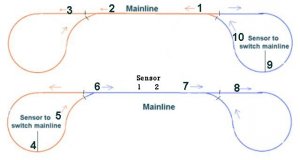My new layout idea is beginning to take shape, and I have a reverse loop question for you electrical gurus. This is not a DCC layout, just a regular block-type setup.
I'd like to have a point-to-point layout, with reverse loops at each end for occaisions when I just want to watch trains go by. (That seems to be fairly often, actually... )
)
I am aware that they have to be wired differently somehow in order to avoid a short circuit, but I am essentially a complete reverse loop naif. Here are my questions.
>1.) Can a train go continuously through these loops, or do I have to stop the train, and physically flip a switch to alter polarity or something every time that train gets inside the reverse loop?
>2.) Am I going to have to get some sort of 300 dollar nuclear-powered (Rocket science degree required) switch gizmo thingy just to have continuous running?
>3.) Would I, as an electrical IDIOT, be better off just running a hidden return track, completely avoiding all need for these two reverse loops?
I would much rather have these return loops, as it would be really nice to be able to see the trains running through the layout both ways, but I wonder if something like this is beyond my abilities.
Really looking forward to any help.
I'd like to have a point-to-point layout, with reverse loops at each end for occaisions when I just want to watch trains go by. (That seems to be fairly often, actually...
I am aware that they have to be wired differently somehow in order to avoid a short circuit, but I am essentially a complete reverse loop naif. Here are my questions.
>1.) Can a train go continuously through these loops, or do I have to stop the train, and physically flip a switch to alter polarity or something every time that train gets inside the reverse loop?
>2.) Am I going to have to get some sort of 300 dollar nuclear-powered (Rocket science degree required) switch gizmo thingy just to have continuous running?
>3.) Would I, as an electrical IDIOT, be better off just running a hidden return track, completely avoiding all need for these two reverse loops?
I would much rather have these return loops, as it would be really nice to be able to see the trains running through the layout both ways, but I wonder if something like this is beyond my abilities.
Really looking forward to any help.




